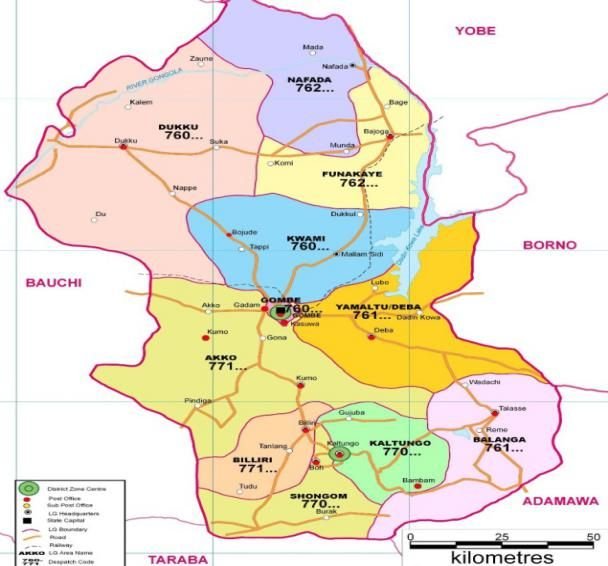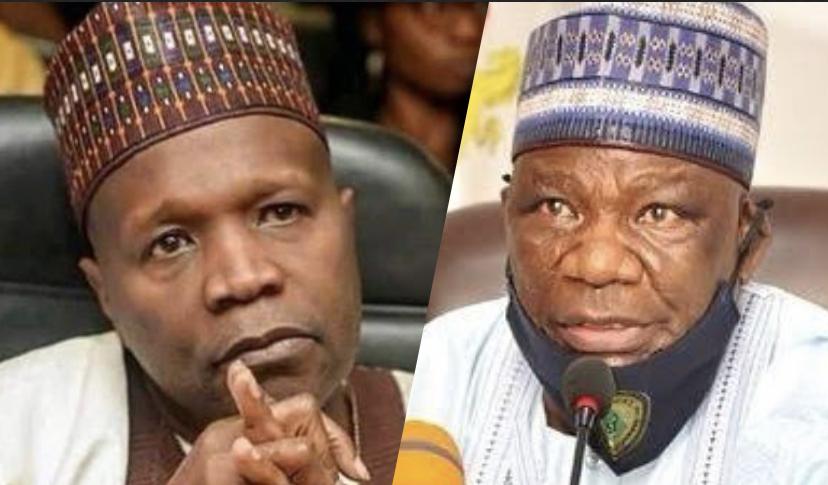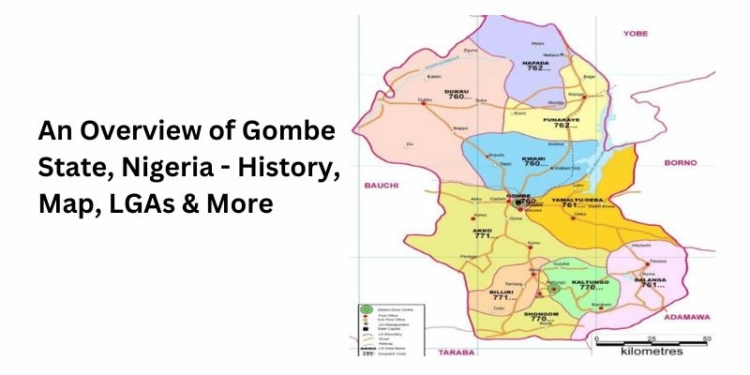Have you ever been to Gombe State in northeastern Nigeria? If No, don’t worry, you’re about to get an inside look at this fascinating place. Nestled within the savanna region of West Africa, Gombe has a rich history and culture just waiting to be explored.
In this article, we will explore the history, demographics, culture, and politics of Gombe State.
A Brief History of Gombe State, Nigeria
Gombe State was created on the 1st of October, 1996, when it was carved out of Bauchi State. The state derives its name from the Gombe Emirate, a traditional state located within its borders. Gombe State is the 21st largest state in Nigeria and the 32nd most populous, with an estimated population of around 3.25 million as of 2016. “Jewel in the Savannah” is the state’s slogan.
The region has been inhabited for centuries by tribes like the Tangale, Waja, and Fulani. The British gained control of the area in 1901, and Gombe became part of the Northern Region. After Nigerian independence in 1960, Gombe was integrated into the North-Eastern State.
In 1967, Gombe joined Bauchi State and remained so until 1996. On 1 October 1996, Gombe State was established, with its capital at Gombe town. The state has 11 local government areas and covers an area of 20,265 square kilometers with an estimated population of around 3 million.
Gombe State Geography, Climate, and Map
Gombe State has a tropical savanna climate with dry and rainy seasons, Gombe has a partly overcast dry season and year-round high temperatures. The wet season is unpleasant and cloudy. Throughout the year, the temperature rarely goes below 52 °F or climbs over 105 °F, with temperatures typically ranging from 57 °F to 100 °F.
The state’s geography consists mostly of plains, with some scattered hills. The highest point is Pan Kilang Hill in Kaltungo LGA, Gombe state. Pan Kilang Hill has an elevation of 1,102 meters above sea level. Two major river systems flow through Gombe: the Benue and Gongola Rivers. These provide water for fishing and irrigation to support agriculture.
Gombe State is located in the northeastern region of Nigeria, bordered to the north and northeast by the states of Borno for 93 km in the vicinity of Gongola River and Lake Dadin Kowa and Yobe in the vicinity of Gongola River for 140 km, to the south by Taraba State for 58 km, to the southeast by Adamawa State for 95 km, and to the west by Bauchi State for 277 km (172 miles). The state capital and largest city is Gombe. There are 11 Local Government Areas (LGAs) in Gombe State. The LGAs are Akko, Balanga, Billiri, Dukku, Funakaye, Gombe, Kaltungo, Kwami, Nafada, Shongom and Yamaltu/Delta.
An Image of the MAP of Gombe

With its savanna landscape, rivers, and hills, Gombe State offers scenic natural beauty. The state’s location in the northeast provides opportunities for trade and commerce with neighboring states and countries like Chad and Cameroon.
Local Government Areas (LGAs) in Gombe
Gombe State is made up of 11 Local Government Areas and 14 Emirates/chiefdoms. It has 3 Senators and 6 Members in the National Assembly. Each LGA is governed by an elected chairman.
The LGAs in Gombe State are:
- Akko
- Balanga
- Billiri
- Dukku
- Funakaye
- Gombe
- Kaltungo
- Kwami
- Nafada
- Shongom
- Yamaltu/Deba
These LGAs were created to bring the government closer to the people at the grassroots level. Each LGA has a council secretariat where the chairman and his councilors operate to oversee the administration of the area.
Here is a table showing the LGAs, their land areas, population, administrative capitals and postal codes of each LGAs.
| LGA | Area (km2) | Census 2006
population |
Administrative capital | Postal
code |
|---|---|---|---|---|
| Akko | 2,627 | 337,853 | Kumo | 771 |
| Balanga | 1,626 | 212,549 | Tallase | 761 |
| Billiri | 737 | 202,144 | Billiri | 771 |
| Dukku | 3,815 | 207,190 | Dukku | 760 |
| Funakaye | 1,415 | 236,087 | Bajoga | 762 |
| Gombe | 52 | 268,000 | Gombe (city) | 760 |
| Kaltungo | 881 | 149,805 | Kaltungo | 770 |
| Kwami | 1,787 | 195,298 | Mallam Sidi | 760 |
| Nafada | 1,586 | 138,185 | Nafada | 762 |
| Shongom | 922 | 151,520 | Boh | 770 |
| Yamaltu/Deba | 1,981 | 255,248 | Deba | 761 |
The LGAs in Gombe State were created by the federal government based on certain factors like population, landmass, ethnicity, history, economy, and administrative convenience.
The People and Culture of Gombe State
The major ethnic groups in Gombe State are Fulani, Tera, Tangale, Waja, Bolewa, Tula, Kanuri, and Hausa. The state has over 40 ethnic groups, with Hausa and Fulani being the largest. The Fulani dominate 7 out of the 11 Local Government Areas of the state.
Language
The major languages spoken are Hausa, Tera, Fulfulde, and Tangale. Hausa is the lingua franca of the state.
Languages of Gombe State listed by LGA:
| LGA | Languages |
|---|---|
| Akko | Fulani; Kanuri; Jukun; Tangale; Tera |
| Balanga | Bangwinji; Centúúm; Dadiya; Dera; Dikaka; Dza; Kyak; Longuda; Moo; Tangale; Tso; Waja |
| Billiri | Tangale, Fulani |
| Dukku | Fulani; Kanuri; Bolewa |
| Funakaye | Fulani; Kanuri; Tera |
| Kaltungo | Awak; Tangale; Tula; Kamo |
| Kwami | Fulani; Bolewa; Kanuri; Tera |
| Nafada | Fulani; Bolewa; Hausa |
| Shongom | Tangale; Kushi; Moo; Loo; Wurkun |
| Yamaltu-Deba | Tera; Bolewa, Fulani; Kanuri |
Cuisine
Popular local cuisines include Tuwo, Fufu, and Kunu. Tuwo is made from corn, millet or rice. Fufu is pounded yam, plantain, or cocoyam. Kunu is a non-alcoholic drink made from millet, sorghum or corn.
Festivals
Popular festivals include the annual Tangale Cultural Festival, showcasing Tangale culture with traditional dances, the Emir of Gombe’s coronation anniversary featuring a durbar of horses, the Pissi Tangle Festival, and the Kamo Cultural Festival.
The culture of Gombe State reflects a diverse blend of traditions. Strong Islamic influences are seen in cultural practices. Traditional arts include leatherworks, blacksmithing, pottery, and cloth weaving. Music, dance and oral storytelling are important parts of the cultural heritage.
Religion
Gombe state is dominated by Islam, practiced by about 95% of the population.
Occupations in Gombe State
Gombe State’s economy depends heavily on agriculture, employing about 70% of the population.
The major crops grown are:
- Groundnuts: Gombe is one of the largest producers of groundnuts in Nigeria. Groundnuts are a major cash crop and source of income for farmers.
- Cotton: Cotton is also widely cultivated and Gombe is a major cotton producer. Cotton farming provides employment to many people in the state.
- Maize: Maize is cultivated both for commercial and subsistence purposes. It is a staple food crop for the people.
- Rice: Rice is grown in the fertile lands around river basins and valleys.
- Millet: Millet is cultivated as a staple crop, especially in the northern parts of the state.
In addition to farming, other occupations include:
- Trading: There is a lot of commercial activity and trading of agricultural produce and livestock in major towns and markets across the state.
- Cattle rearing: Cattle rearing is an important occupation for the Fulani people who inhabit the state. Livestock farming is a significant part of the agricultural sector, with cattle, goats, sheep, and poultry being raised.
- Fishing: Fishing is carried out in rivers, streams, lakes, and dams, providing jobs and food sources.
- Mining: Mining of limestone, gypsum, clay, coal, etc., provides employment to some people.
Gombe’s economy is largely rural and depends on rain-fed agriculture and livestock rearing. The government is working to diversify the economy through mining, tourism, and industrial growth.
Tourist Centers in Gombe State
Gombe State is blessed with many tourist attractions due to its diverse landscape, culture, and history. Some major tourist centers you should visit include Gombe Kaltungo Warm Springs, Mbormi Battle Ground, Emir of Gombe Palace, Tangale Hills, Lake Dadin Kowa, and Gombe National Park.
Natural Resources in Gombe State
Gombe State is rich in mineral resources such as gypsum, limestone, kaolin, tantalite, galena, iron ore, gemstones, salt, and bentonite. It also has agricultural resources like cotton, groundnuts, maize, rice, millet, cowpea, and cassava.
Who is the Governor and Deputy Governor of Gombe State?

The current Governor of Gombe State is Alhaji Muhammadu Inuwa Yahaya of the All Progressives Congress (APC). He was elected as Governor in the 2019 gubernatorial election, succeeding Ibrahim Hassan Dankwambo. Prior to becoming Governor, Yahaya served as the Commissioner of Finance and Economic Planning in Gombe State under Governor Danjuma Goje.
The Deputy Governor of Gombe State is Manassah Daniel Jatau Ph.D.; he is a retired Deputy Comptroller of Customs now serving as Deputy.
Together, Governor Inuwa Yahaya and Deputy Governor Manassah Daniel Jatau oversee the administration of Gombe State and ensure the state government carries out policies, projects, and programs to benefit the people. They work with commissioners, special advisers, and other government officials to manage key ministries, departments, and agencies in the state.
Prominent People From Gombe State
Some of the most well-known people from Gombe State include:
- Amina Mohammed, UN deputy secretary
- Usman Faruk, the first military governor of the defunct northwestern state
- Isa Ali Pantami, preacher and Minister of communication
- Joshua M. Lidani, politician
- Samkon Gado, Nigerian-American otolaryngologist and American football player
- Danladi Mohammed, politician
- Usman Bayero Nafada, politician
Key Industries and Economic Activities in Gombe State
Gombe State has a number of key industries and economic activities that drive its economy.
Agriculture
As an agrarian state, agriculture employs about 70-80% of Gombe’s population. The major crops are cotton, groundnuts, rice, millet, maize, cowpea, sweet potatoes, and cassava. Livestock farming of cattle, sheep, goats, and poultry is also popular.
Mining
Gombe State is rich in mineral deposits like gypsum, limestone, clay, coal, tin, and columbite. Mining activities are mainly small-scale, with some commercial mining of limestone and gypsum by companies like Ashaka Cement Company.
Trade and Commerce
There are a lot of trading and commercial activities in Gombe’s major towns and markets. Foodstuffs, agricultural produce, livestock, crafts, and manufactures are traded. Weekly markets and periodic international trade fairs boost economic activities.
Forestry
Gombe State has significant forest reserves, exploiting timber, firewood, poles and bamboo. Community forestry and private woodlots also contribute to the forestry sector.
Tourism
Gombe State has potential for tourism with attractions like Gombe Emir’s Palace, Nafada Game Reserve, Lake Dadin Kowa and the Muri Mountains. However, the tourism industry is still developing.
Industries
There are small manufacturing industries producing goods like textiles, leather works, crafts, flour, feed mills, bakeries, and furniture. The state also has two major cement factories – Ashaka Cement and Dangote Cement.
Civil Service
The public sector employs many residents of Gombe State. Teachers, medical staff, administrators, and security personnel work for the state and federal governments.
While the economy has grown in recent years, Gombe still faces significant challenges like poverty, unemployment, and lack of infrastructure and social services. Ongoing efforts to diversify the economy beyond agriculture and mining, strengthen the private sector, and improve education and healthcare aim to boost economic opportunity and quality of life for citizens.
Is Gombe State safe to visit?
Gombe State is generally safe to visit, but there are occasional security issues. Exercise caution, avoid remote areas, and check current events before your trip. Stick to well-trafficked routes and public places.
Conclusion
So there you have it, a quick overview of Gombe State. While it may be small in size, it’s rich in culture and natural beauty. From the Gombe Emirate to the Gombe Stream, there’s a lot of history and scenic spots to explore in this little corner of Nigeria. The state’s diverse landscape, from hills to plains to waterfalls, provides opportunities for hiking, camping, and other adventures. And with 11 local government areas, each with their own festivals and traditions, you’ll never run out of cultural experiences. There’s more to discover here than meets the eye.


Discussion about this post